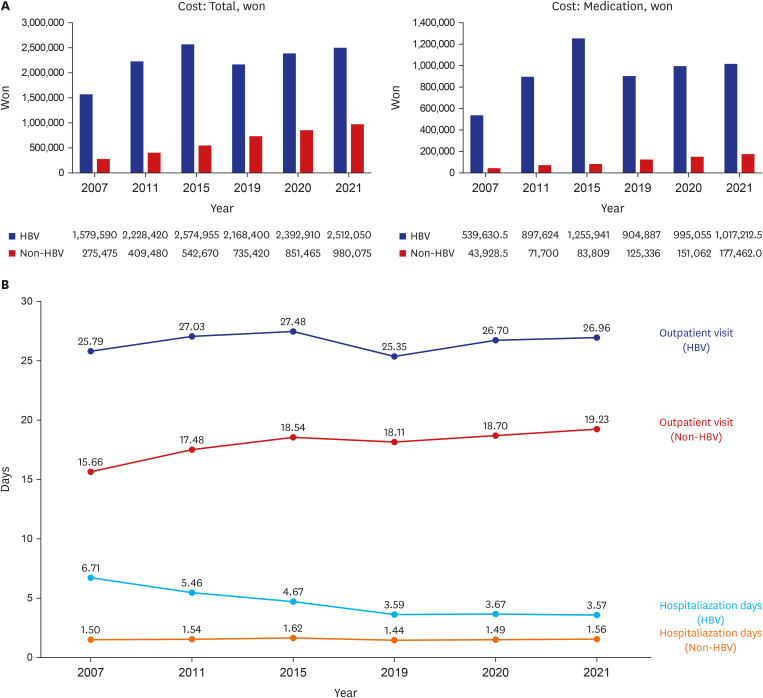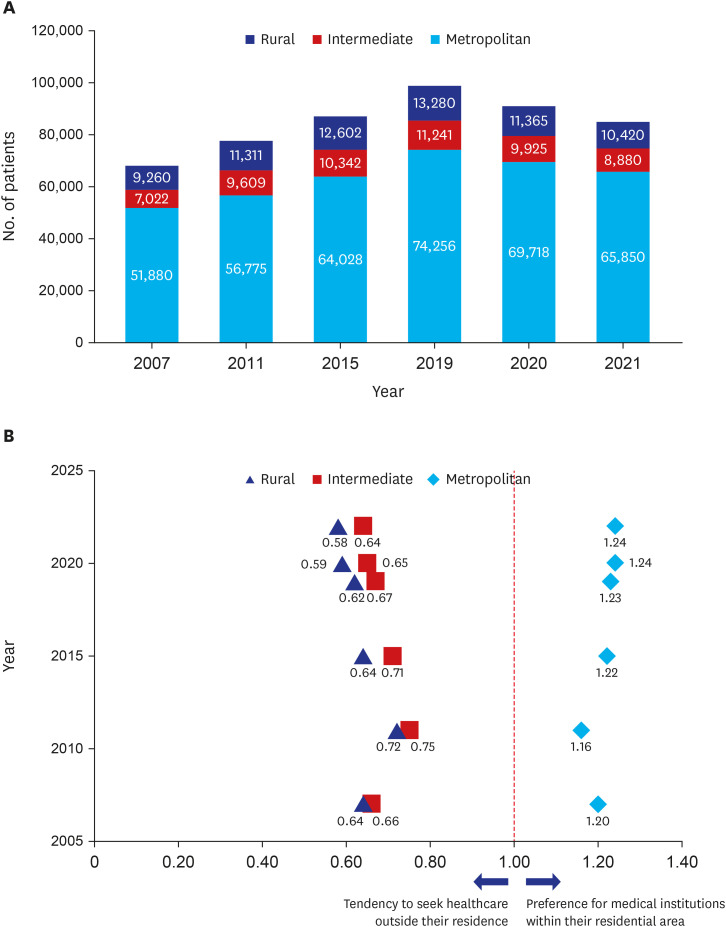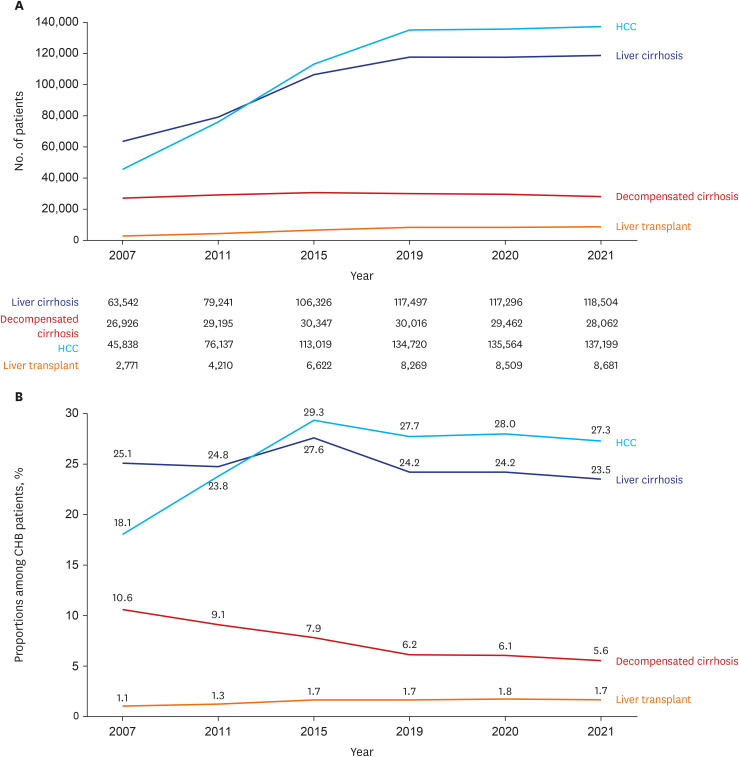J Korean Med Sci.
2024 Jan;39(4):e22. 10.3346/jkms.2024.39.e22.
The Epidemiology of Hepatitis B Virus Infection in Korea: 15-Year Analysis
- Affiliations
-
- 1Department of Big DATA Strategy, National Health Insurance Service, Wonju, Korea
- 2Department of Internal Medicine, Soonchunhyang University Bucheon Hospital, Bucheon, Korea
- 3Institute for Digestive Research, Digestive Disease Center, Department of Internal Medicine, Soonchunhyang University College of Medicine, Seoul, Korea
- 4Department of Internal Medicine, Wonkwang University School of Medicine and Wonkwang University Hospital, Iksan, Korea
- 5Department of Internal Medicine, Chung-Ang University Hospital, Seoul, Korea
- 6Department of Internal Medicine, Catholic Kwandong University College of Medicine, St. International Mary’s Hospital, Incheon, Korea
- 7Department of Internal Medicine, Seoul Metropolitan Government-Seoul National University Boramae Medical Center, Seoul, Korea
- KMID: 2551965
- DOI: http://doi.org/10.3346/jkms.2024.39.e22
Abstract
- Background
The purpose of this study is to investigate the epidemiological changes in chronic hepatitis B (CHB) and assess the impact of coronavirus disease 2019 (COVID-19) over the past 15 years in a region endemic to hepatitis B virus (HBV).
Methods
National Health Insurance Service claims data of hepatitis B patients spanning from 2007 to 2021 was utilized. To compare the characteristics of the hepatitis B group, a control group adjusted for age and gender through propensity score matching analysis was established.
Results
The number of patients with CHB has consistently increased over the past 15 years. The average age of the CHB patient group has shown a yearly rise, while the prevalence of male dominance has gradually diminished. The proportions of hepatocellular carcinoma, liver cirrhosis, and decompensation have exhibited a declining pattern, whereas the proportion of liver transplants has continuously risen. Patients with CHB have demonstrated significantly higher medical and medication costs compared to the control group. Moreover, patients with CHB have shown a higher prevalence of comorbidities along with a significantly higher rate of concomitant medication usage. During the COVID period, the HBV group experienced a substantial decrease in the number of outpatient visits and overall medical costs compared to the control group.
Conclusion
The epidemiology of CHB has undergone significant changes over the past 15 years, encompassing shifts in prevalence, severity, medical costs, and comorbidities. Furthermore, the impact of COVID-19 has been observed to decrease healthcare utilization among patients with CHB when compared to controls.
Keyword
Figure
Reference
-
1. Chien RN, Liaw YF. Current trend in antiviral therapy for chronic hepatitis B. Viruses. 2022; 14(2):434. PMID: 35216027.2. Broquetas T, Carrión JA. Current perspectives on nucleos(t)ide analogue therapy for the long-term treatment of hepatitis B virus. Hepat Med. 2022; 14:87–100. PMID: 35936810.3. Les I, García-Martínez R, Córdoba J, Quintana M, Esteban R, Buti M. Current trends in chronic hepatitis B management: results of a questionnaire. Eur J Gastroenterol Hepatol. 2009; 21(10):1177–1183. PMID: 19430301.4. Perrillo RP, Marcellin P. Effect of newer oral antiviral agents on future therapy of chronic hepatitis B. Antivir Ther. 2010; 15(1):13–22. PMID: 20167987.5. Liu LZ, Sun J, Hou J, Chan HL. Improvements in the management of chronic hepatitis B virus infection. Expert Rev Gastroenterol Hepatol. 2018; 12(11):1153–1166. PMID: 30269597.6. Yim SY, Kim JH. The epidemiology of hepatitis B virus infection in Korea. Korean J Intern Med. 2019; 34(5):945–953. PMID: 30919608.7. Sinn DH. Natural history and treatment indications of chronic hepatitis B. Korean J Gastroenterol. 2019; 74(5):245–250. PMID: 31765552.8. Korean Liver Cancer Association (KLCA); National Cancer Center (NCC) Korea. 2022 KLCA-NCC Korea practice guidelines for the management of hepatocellular carcinoma. J Liver Cancer. 2023; 23(1):1–120. PMID: 37384024.9. Choi S, Kim BK, Yon DK, Lee SW, Lee HG, Chang HH, et al. Global burden of primary liver cancer and its association with underlying aetiologies, sociodemographic status, and sex differences from 1990-2019: a DALY-based analysis of the Global Burden of Disease 2019 study. Clin Mol Hepatol. 2023; 29(2):433–452. PMID: 36597018.10. Pley CM, McNaughton AL, Matthews PC, Lourenco J. The global impact of the COVID-19 pandemic on the prevention, diagnosis and treatment of hepatitis B virus (HBV) infection. BMJ Glob Health. 2021; 6(1):e004275.11. Kim Y, Gordon A, Rowerdink K, Herrera Scott L, Chi W. The impact of the COVID-19 pandemic on health care utilization among insured individuals with common chronic conditions. Med Care. 2022; 60(9):673–679. PMID: 35866561.12. Kondili LA, Buti M, Riveiro-Barciela M, Maticic M, Negro F, Berg T, et al. Impact of the COVID-19 pandemic on hepatitis B and C elimination: an EASL survey. JHEP Rep. 2022; 4(9):100531. PMID: 35967191.13. Xiridou M, Adam P, Meiberg A, Visser M, Matser A, de Wit J, et al. The impact of the COVID-19 pandemic on hepatitis B virus vaccination and transmission among men who have sex with men: a mathematical modelling study. Vaccine. 2022; 40(33):4889–4896. PMID: 35810058.14. Llovet JM, Kelley RK, Villanueva A, Singal AG, Pikarsky E, Roayaie S, et al. Hepatocellular carcinoma. Nat Rev Dis Primers. 2021; 7(1):6. PMID: 33479224.15. Halegoua-De Marzio D, Hann HW. Then and now: the progress in hepatitis B treatment over the past 20 years. World J Gastroenterol. 2014; 20(2):401–413. PMID: 24574709.16. Kim DY. History and future of hepatitis B virus control in South Korea. Clin Mol Hepatol. 2021; 27(4):620–622. PMID: 34555278.17. Song BG, Sinn DH, Kang W, Gwak GY, Paik YH, Choi MS, et al. Changes in the prevalence of hepatitis B and metabolic abnormalities among young men in Korea. Korean J Intern Med. 2022; 37(5):1082–1087. PMID: 35569823.18. Lee YS, Lee HS, Kim JH, Chang SW, Hyun MH, Bak H, et al. Role of tenofovir disoproxil fumarate in prevention of perinatal transmission of hepatitis B virus from mother to child: a systematic review and meta-analysis. Korean J Intern Med. 2021; 36(1):76–85. PMID: 31878771.19. Cho EJ, Kim SE, Suk KT, An J, Jeong SW, Chung WJ, et al. Current status and strategies for hepatitis B control in Korea. Clin Mol Hepatol. 2017; 23(3):205–211. PMID: 28942624.20. Choi HR, Kim BS, Won CW, Ahn HC. HBsAg and anti-HBs prevalence in North Korean defectors. J Korean Acad Fam Med. 1999; 20(12):1778–1783.21. Yoo SH, Kim SS, Kim SG, Kwon JH, Lee HA, Seo YS, et al. Current status of ultrasonography in national cancer surveillance program for hepatocellular carcinoma in South Korea: a large-scale multicenter study. J Liver Cancer. 2023; 23(1):189–201. PMID: 37384020.22. Terrault NA, Lok AS, McMahon BJ, Chang KM, Hwang JP, Jonas MM, et al. Update on prevention, diagnosis, and treatment of chronic hepatitis B: AASLD 2018 hepatitis B guidance. Hepatology. 2018; 67(4):1560–1599. PMID: 29405329.23. GBD 2019 Hepatitis B Collaborators. Global, regional, and national burden of hepatitis B, 1990-2019: a systematic analysis for the Global Burden of Disease Study 2019. Lancet Gastroenterol Hepatol. 2022; 7(9):796–829. PMID: 35738290.24. Korean Association for the Study of the Liver (KASL). KASL clinical practice guidelines for management of chronic hepatitis B. Clin Mol Hepatol. 2019; 25(2):93–159. PMID: 31185710.25. Kim DS, Park SY, Kim BK, Park JY, Kim DY, Han KH, et al. Revised Korean antiviral guideline reduces the hepatitis B-related hepatocellular carcinoma risk in cirrhotic patients. J Korean Med Sci. 2021; 36(16):e105. PMID: 33904261.26. Lee HW. Long term efficacy of antiviral therapy: mortality and incidence of hepatocellular carcinoma. Korean J Gastroenterol. 2019; 74(5):251–257. PMID: 31765553.27. Jang WY, Chung WJ, Jang BK, Hwang JS, Lee HJ, Hwang MJ, et al. Changes in characteristics of patients with liver cirrhosis visiting a tertiary hospital over 15 years: a retrospective multi-center study in Korea. J Korean Med Sci. 2020; 35(29):e233. PMID: 32715667.28. Jang W, Lee HW, Lee JS, Kim BK, Kim SU, Park JY, et al. Clinical characteristics and prognosis of Korean patients with hepatocellular carcinoma with respect to etiology. J Liver Cancer. 2022; 22(2):158–166. PMID: 37383415.29. Lee H, Kim BK, Jang S, Ahn SH. Cost-effectiveness analysis of antiviral therapy for untreated minimally active chronic hepatitis B to prevent liver disease progression. Clin Transl Gastroenterol. 2021; 12(2):e00299. PMID: 33600103.30. Webb E, Hernández-Quevedo C, Williams G, Scarpetti G, Reed S, Panteli D. Providing health services effectively during the first wave of COVID-19: a cross-country comparison on planning services, managing cases, and maintaining essential services. Health Policy. 2022; 126(5):382–390. PMID: 34246501.
- Full Text Links
- Actions
-
Cited
- CITED
-
- Close
- Share
- Similar articles
-
- Prevention of Viral Hepatitis and Vaccination
- Clinical Significance of Outbreak of Hepatitis A Virus Infection in Endemic Area with Hepatitis B and C Virus Infection
- Epidemiology and prevention of hepatitis B virus infection
- Prevalence and Clinical Implications of Occult Hepatitis B Virus Infection
- A stochastic analysis on the force of infection by hepatitis B virus in Korea




